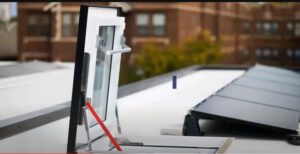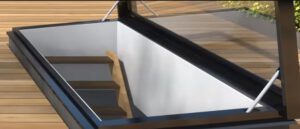Can I Install a Roof Access Hatch on My Australian Home?
 When it comes to home improvement and maintenance, ensuring easy and safe access to various areas of your property is of utmost importance. Installing a roof access hatch can provide numerous benefits, including efficient maintenance, improved ventilation, and even enhanced emergency evacuation options. However, before embarking on such a project, it is crucial to understand the regulations, considerations, and practicalities associated with installing a roof access hatch in an Australian home. In this article, we will delve into the various subtopics relevant to this topic, including the legal requirements, structural considerations, installation process, and maintenance aspects.
When it comes to home improvement and maintenance, ensuring easy and safe access to various areas of your property is of utmost importance. Installing a roof access hatch can provide numerous benefits, including efficient maintenance, improved ventilation, and even enhanced emergency evacuation options. However, before embarking on such a project, it is crucial to understand the regulations, considerations, and practicalities associated with installing a roof access hatch in an Australian home. In this article, we will delve into the various subtopics relevant to this topic, including the legal requirements, structural considerations, installation process, and maintenance aspects.
Understanding the Legal Requirements
Before proceeding with any modifications to your home, it is essential to familiarize yourself with the relevant building codes and regulations in Australia. While these regulations may vary slightly between states and territories, there are some common requirements to consider when installing a roof access hatch:
- Building Codes and Standards: In Australia, building regulations are primarily governed by the National Construction Code (NCC), which sets out the minimum requirements for safety, accessibility, and construction. The NCC provides guidelines for access and egress, including the installation of roof access hatches.
- Local Council Requirements: Additionally, local councils may have their own specific requirements regarding home modifications. It is important to check with your local council for any additional regulations or permits needed for installing a roof access hatch.
- Safety Standards: Safety is paramount, so ensure that the access hatch and ladder system you choose comply with the relevant safety standards, such as the Australian Standard AS1657 for fixed platforms, walkways, stairways, and ladders.
Structural Considerations
Installing a roof access hatch requires careful consideration of the structural integrity of your home. Here are some important factors to keep in mind:
- Load-Bearing Capacity: Roof access hatches typically require a supporting structure, such as a curb or frame, to be installed on the roof. Before proceeding, you need to assess whether your roof can withstand the additional load imposed by the access hatch and ladder system. Consulting a structural engineer or a qualified builder can help ensure the roof’s load-bearing capacity is not compromised.
- Roof Type and Material: The type and material of your roof will influence the installation process. Different roof types, such as flat, pitched, or curved roofs, may require specific installation methods. Moreover, the roofing material, whether tiles, metal sheets, or other types, will impact the compatibility and installation of the access hatch.
- Waterproofing and Insulation: When installing a roof access hatch, it is vital to maintain the integrity of your roof’s waterproofing and insulation. Proper sealing techniques and materials must be employed to prevent water leaks, drafts, and potential energy loss.
Installation Process
 Once you have assessed the legal requirements and structural considerations, it’s time to move on to the installation process. While it is recommended to hire a professional for this task, understanding the general steps involved can give you a better understanding of the process:
Once you have assessed the legal requirements and structural considerations, it’s time to move on to the installation process. While it is recommended to hire a professional for this task, understanding the general steps involved can give you a better understanding of the process:
- Site Assessment and Preparation: Begin by determining the ideal location for the access hatch on your roof. Consider factors such as ease of access, proximity to desired areas, and overall aesthetic impact. Once the location is decided, prepare the site by removing roofing materials and ensuring a clean, level surface.
- Installation of the Access Hatch: Install the curb or frame that will support the access hatch. Follow the manufacturer’s instructions and ensure proper anchoring and waterproofing of the frame.
- Ladder Installation: Depending on the design and configuration, install the ladder system that will provide safe access to and fromthe access hatch. Ensure that the ladder is securely fastened and complies with safety standards.
- Sealing and Insulation: Properly seal the access hatch and surrounding area to prevent water leaks and maintain insulation. Use appropriate sealing materials and techniques recommended by the manufacturer.
- Finishing Touches: Finally, perform a thorough inspection to ensure everything is properly installed and sealed. Make any necessary adjustments and perform a final waterproofing check before completing the installation process.
Maintenance and Safety Considerations
Installing a roof access hatch is not a one-time task. Regular maintenance and adherence to safety guidelines are crucial to ensure the longevity and safety of the access hatch. Here are some essential maintenance and safety considerations:
- Regular Inspections: Periodically inspect the access hatch, ladder, and surrounding areas for any signs of damage, deterioration, or wear. Pay close attention to the sealing and waterproofing, ensuring there are no leaks or drafts.
- Cleaning and Clearing: Keep the access hatch area clean and free from debris, leaves, or other obstructions that may hinder proper functionality or pose safety risks.
- Safety Measures: Implement safety measures such as non-slip surfaces on the ladder steps, handrails, and proper lighting around the access hatch area. Consider installing a lock or security feature to prevent unauthorized access.
- Maintenance Checklist: Create a maintenance checklist that includes tasks such as lubricating hinges, tightening bolts and screws, inspecting the ladder’s stability, and checking for any signs of rust or corrosion.
- Professional Inspections: Consider scheduling periodic professional inspections to assess the overall condition and functionality of the roof access hatch and ladder system.
Conclusion
Installing a roof access hatch in your Australian home can significantly enhance convenience, maintenance efficiency, and safety. However, it is crucial to navigate the legal requirements, consider structural aspects, follow proper installation procedures, and prioritize regular maintenance and safety considerations. By adhering to these guidelines, you can successfully install a roof access hatch that meets the necessary regulations and ensures safe and convenient access to your roof area. Remember to consult with professionals and obtain the required permits to ensure a smooth and compliant installation process.
CAN I INSTALL A LIGHTNING PROTECTION SYSTEM ON MY AUSTRALIAN ROOF?

Links
- Why Choose
- About Us
- Case Studies
- Our Services
- Contact
Services
- Petroleum and Gas
- Industrial Construction
- Chemical Research
- Mechanical Engineering
- Power Energies
© 2021 By Magic Page Plugin
- Home
- About
- Services
- Contact
